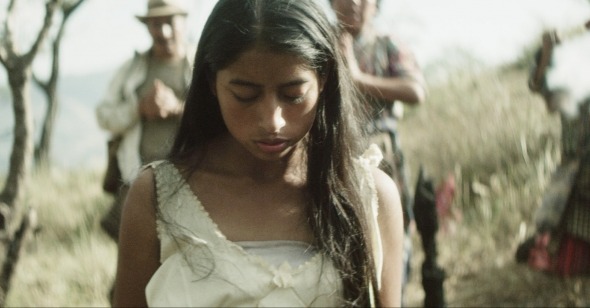The Look of Silence
by Amanda Arnold
Ixcanul
Dir. Jayro Bustamante, Guatemala, Kino Lorber
MarĂa only seems capable of conveying an intensely morose gaze, though very rarely does one catch a glimpse of it; her deep-brown almond eyes, shrouded by heavy eyelids, don’t often focus on anything other than the ground on which she stands. Were she a minor character in Ixcanul, this might be unnoteworthy—she’d be just another static figure in the frame. As the protagonist, though, it’s unusual that her eyes don’t often catch the camera and that her dialogue is minimal. This isn’t without reason: as a 17-year-old living in an indigenous community on top of an active volcano, she is seen as a mere female body in her culture. But, like a volcano, her spirit and sexuality can’t always lie dormant.
The debut feature of Guatemalan writer-director Jayro Bustamante, Ixcanul is a coming-of-age story—though as Maria is a girl, her maturation is more or less forced. Played by MarĂa Mercedes Coroy, she’s the only child of a poor Kaqchikel-speaking family in central Guatemala, where she is groomed and betrothed to Ignacio, the owner of the coffee plantation on which she works. And while she internalizes all objection, she seeks to be with Pepe, a plantation worker who dreams of fleeing to America. It is in the few scenes with him that Maria speaks and her eyes are visible; with Pepe, she cannot only be a body, but a teenage girl with emotions and sexual desires. And after a liquor-filled night, she seduces Pepe and loses her virginity to him, which leaves her pregnant, a dire threat to her upcoming marriage to Ignacio.
Maria’s strength is portrayed through her very silence and restraint—she seems to be both on the verge of erupting and in complete control. In the beginning of the film, she and her mother empty bottles of liquor into male and female pigs’ mouths to rile them up for sex, though the camera doesn’t show the animals. Instead, it focuses on Maria as she stares at them, their violent screams echoing. In a later scene, she’s shown rubbing herself against the stump of a tree after the sun has set. Whereas in the first scene, her gaze is numb—an expression of her recognizing herself in the female pig—and highlights her sexuality, the second scene illustrates that which is emotional. In her village, the former can be expressed, the latter not. As much as she desires to break from the traditions of her parents, she lives in the middle of Guatemala without money or knowledge of any language aside from her indigenous Kaqchikel, and is thus bound to her family and land.
While the plot is fictional, Ixcanul at times can feel like a documentary, as Bustamante captures a very real culture that exists in this world. Descendants of the Mayan civilization, Kaqchikel people still reside in the central region of Guatemala—and in fact served as characters in the film. Before shooting, Bustamante, who grew up two hours from the filming location and learned Kaqchikel from his nanny, hosted workshops for women from his hometown of Panajachel to tell him what it’s like to live in their culture as a woman, and the struggles they face. When it came time to cast, he sought out actors from a similar region. While MarĂa TelĂłn, who plays MarĂa’s mother Juana, is a professional actor, the rest of those in the film had only experience from street theater or none at all; they are actual Kaqchikel people, telling Bustamante’s story through their own language and experience, which lends a welcome authenticity to a film that easily could’ve come off as culturally insensitive.
Where there is an occasional lack of refinement in the acting, there is an earnestness that fills it in. With central Guatemala’s volcanic landscape as a backdrop, which is both dramatic and ominous, the elements together feel raw but not crude. There is a sharp contrast between the majesty of the volcano and the vibrant community atop it, and the fact that a volcano can also destroy life so quickly; much of the images highlight the frightening majesty of nature, simultaneously beautiful and extreme. Bustamante also makes sure to highlight the noises of the natural world: Maria and her mother’s violent thwacking at hay, the grating squeals of pigs during sex, and the muted sound of Maria’s feet landing in gravel as she hops from rock to rock while her mother guides her through the superstitious practice meant to make her miscarriage. The cinematography underscores the elemental nature of this world, refusing overt stylization.
While not selected as a finalist, Ixcanul was Guatemala’s first-ever Oscar entry for best foreign-language film in 2015, a year that saw multiple films whose main language was spoken by indigenous peoples (others including being Venezuela’s Lo que lleva el rĂo, in which the language is Warao, and Colombia’s Embrace of the Serpent). And at the 2015 Berlin Film Festival, where it premiered, Ixcanul won the Silver Bear Alfred Bauer Prize, an award given to “a feature film that opens new perspectives.” While characters can seem awkward in how they portray emotions in certain situations, it is its earnest storytelling that opens the world’s perspective. Just as MarĂa’s power is in her restraint, so is the film’s—perceptive and raw, with a strength that needs few words.
